Home » Hunting Videos » Love Letter to North Dakota – A Hungarian Partridge and Sharp-tailed Grouse Story
Love Letter to North Dakota – A Hungarian Partridge and Sharp-tailed Grouse Story

A.J. DeRosa, founder of Project Upland, is a New England…
Watch and read the upland hunting adventures of Tyler Webster of Birds, Booze, and Buds Podcast as pursues sharptails and huns in his native North Dakota.
This is a story of a love letter to North Dakota, a letter not written by me, but one which I had the honor of witnessing. Maybe it’s more like a play where, in Shakespearean fashion, the protagonist faces the challenges of love and never waivers in devotion. The main character is a North Dakota native, a lover of wild spaces, a companion of dogs, and a champion of the shortgrass prairie. His name is Tyler Webster, and for three decades he has carried a shotgun across the North Dakota prairie in pursuit of wild birds. Some may know him as the host of the Birds, Booze, and Buds Podcast formerly known as the Western Wingshooter Podcast.
Presented by: CZ USA
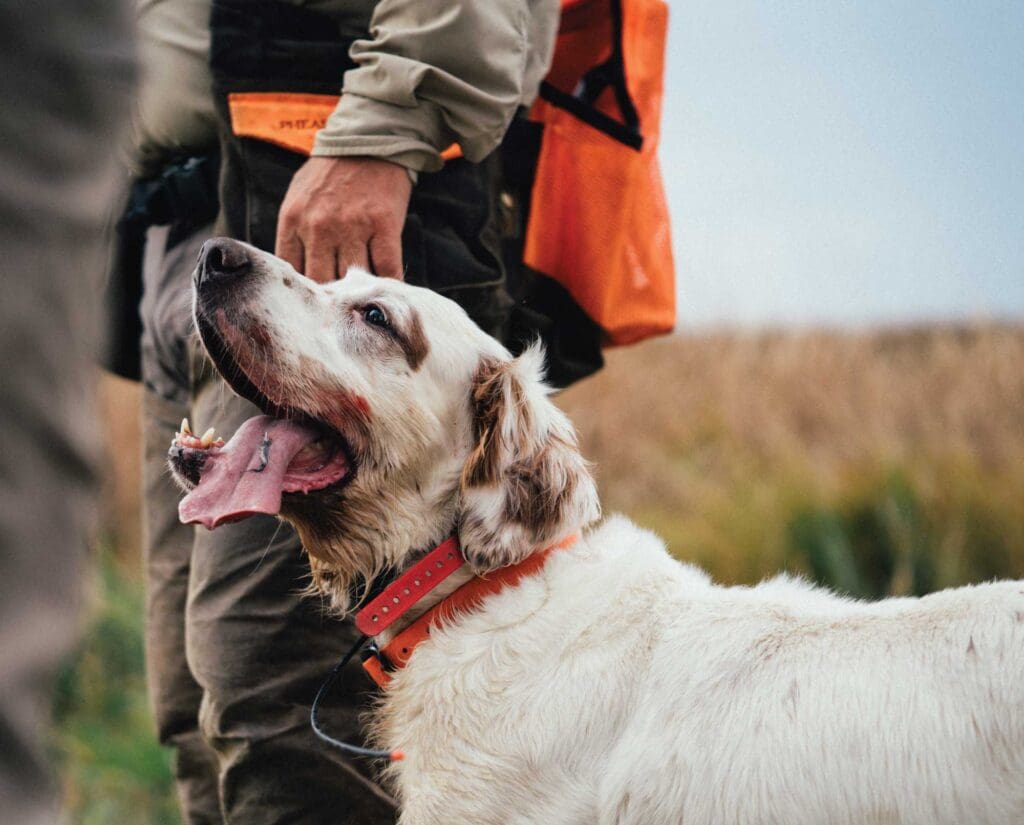
Act One: The Dogs
“This is my 30th year carrying a shotgun,” Tyler said, beginning his upland origin story. “My grandfather got me into bird hunting. It’s just kind of the family business, really. We didn’t really have dogs growing up; we just started hunting as a way of filling in time between trapping season and fishing.”
Tyler has had a fair number of seasons to soak in his surroundings, standing on hills overlooking the prairie to contemplate or at least recognize how he could feel about a place. And Tyler is no stranger to wandering North America in search of upland birds.
“North Dakota is home, and it doesn’t matter how many different places I get to hunt or how many different bird species I get to chase, this is always where I am going want to live,” he said.
Although Tyler wanders to the deserts of the Southwest to finish each season, I think it’s more about him following dogs than a sense of place. His undertone is that of the dogs, the first piece of the story of Tyler’s love for North Dakota.
“I was about 12 years old and we were on a pheasant hunt when we wing-tipped this rooster pheasant,” he said. “It kind of glided down and ended up going into the middle of a stubble field. We had no idea — pheasants are track stars—and that little Brittany slam pointed out in the middle of nothing. We walked up there for 200 yards; you could see that dog standing out there and we tried calling it, but it wouldn’t come. We walked over there and heard that rooster jump up into the air and that dog grabbed it out of the air and brought it back. That moment I was like, ‘This is what I want to do.’”
With about the only tenet that most of us can agree on, he stated, “Dogs are family. I like dogs more than I like people—and I like people. Dogs are life. It’s why we do what we do. I wouldn’t be out there walking 15 miles across prairie trying to shoot sharptails if I didn’t have dogs to watch. The dog work is more important than pulling the trigger by far.”
In our world, dogs mean a lot of things—most things, in fact—and nothing creates a connection like shooting some birds over someone’s dog. I had the pleasure of shooting my first Hun over his oldest, an English Setter named Rusty, whose deliberate and calculated approach to cover emanates the wisdom of an elder. Then there was CJ, a young English Setter accurately nicknamed the Fur Missile. Her trajectory into the prairie would require NASA scientists to interpret at those speeds, but it works. I shot a true double of Huns over her and was awestruck in the chaos. Perhaps my most favorite of the bunch is Bo, an alleged German Shorthaired Pointer, but take one hard look at him and you’ll agree with Tyler’s assessment: “I am pretty sure a Pointer jumped the fence and got his mother pregnant.”
Bo made me feel a special way about the prairie on this trip; while it wasn’t my first trip, he gave me a moment that brought me right back to the first time I had seen sharp-tailed grouse jump up like the “popcorn” pattern they are known for. He stood rigid—it had to be at least 300 yards ahead—as we took our time getting there. On that last hill, before we arrived, we simply stopped and watched him. No need for film when a photo would catch the exact tone of the moment. Tyler’s smile and silence spoke volumes as he just stared. As we walked in on the point, the birds got up in a long row, and I was lost in it. The memory unfolds so slowly, but in reality, it was over in an instant.
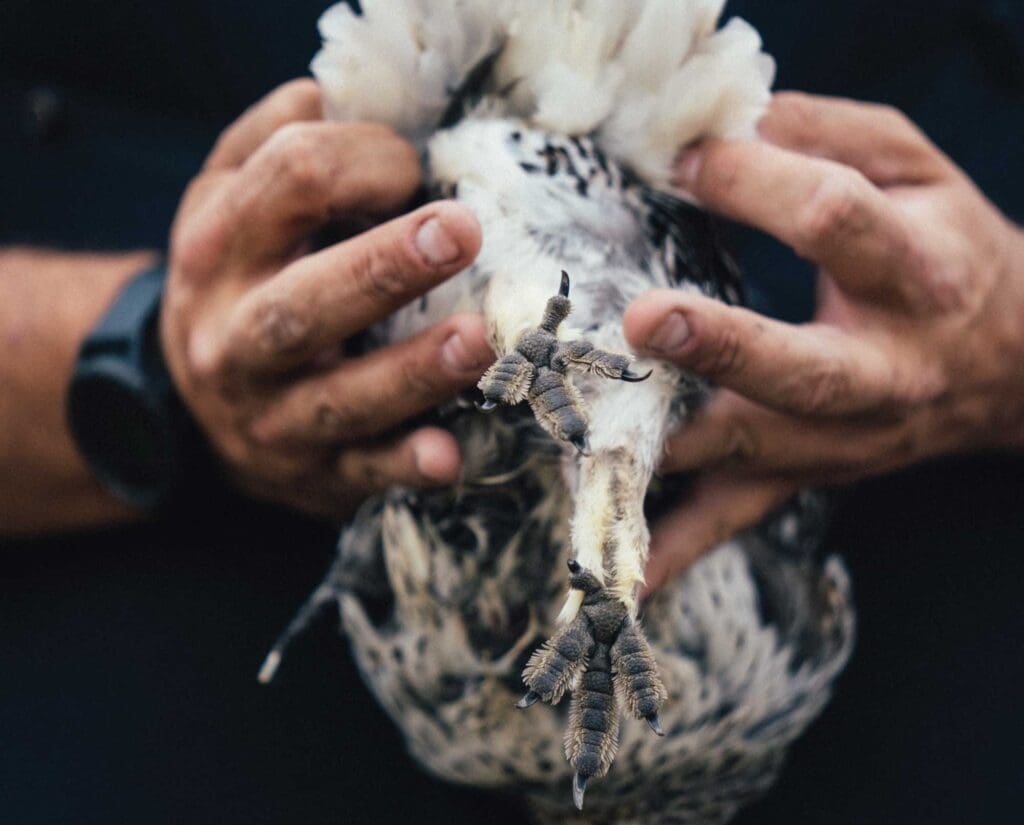
Act Two: The Birds
“The sharptails have been here for thousands of years, literally,” Tyler said.
“They haven’t changed. They are our native game bird species here in North Dakota. The biggest thing that they provide to me is the landscape in which they live. They will punish you. They’re a boot-leather bird. They’re a bird that you may flush a hundred of them before you get a shot at one. They do not tolerate sloppy dog work; the dogs have to be tight. They will make for some of the most memorable, scenic hunts that you will go on.”
While I also have a love for the native sharp-tailed grouse, it was the non-native Hungarian partridge that pulled me across the country on this particular trip. I wanted to see and experience firsthand what Tyler calls “the quail of the North.” They did not disappoint in pursuit or as table fare. Tyler might not have come out and said it, but those Huns certainly occupy a very special place in his heart, too.
“Huns were introduced many times throughout the country but the one that finally took was in Alberta,” he said. “In the early 1900s, they started trying Huns in all these different places. The one that finally took was up there. At the height of their expansion, they were expanding like 30 miles a year in all directions.”
Our few days spent targeting them were ample proof of their success and abundance.
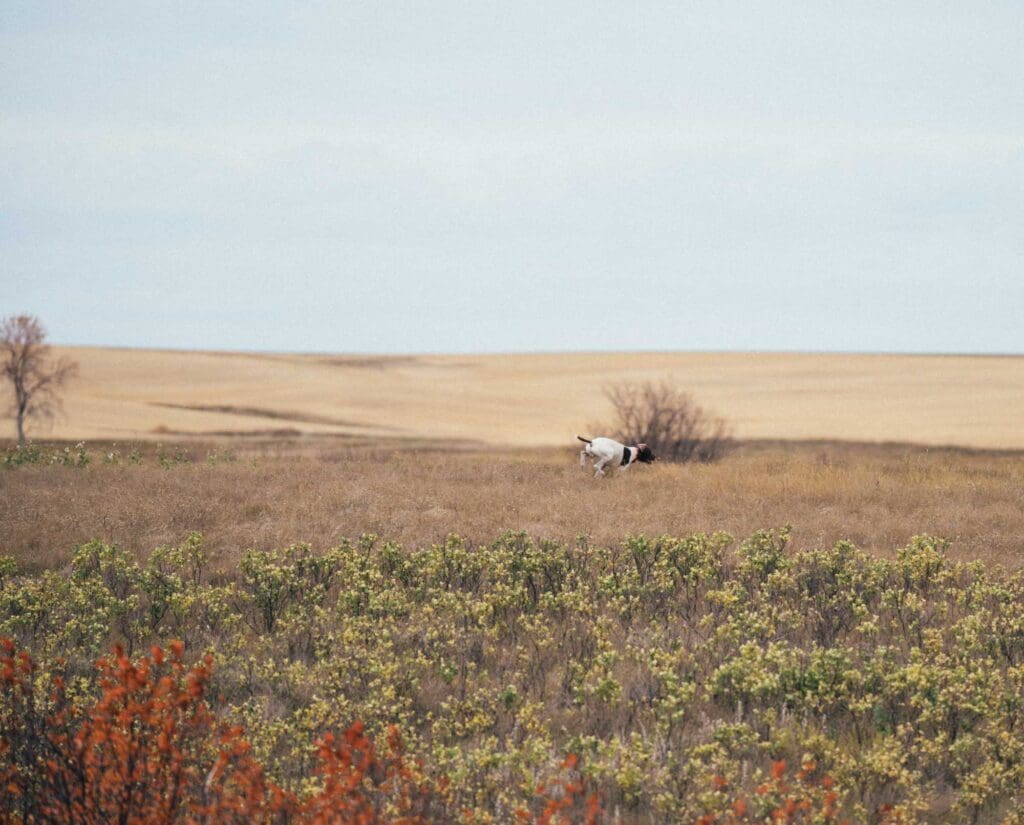
Act Three: Short Grass Prairie
While just about everything Tyler shared on this trip was shared with passion, none rivaled his moments quite like his fever around short grass prairie.
READ: Types of Grasslands in North America
“The shortgrass prairie is the fastest-disappearing ecosystem in the United States,” he said. “It’s home to countless types of plants and animals. The biggest problem is that once the ground is broken, it takes thousands of years to come back. The sod is a foot-thick mix of native grass roots and dirt that takes thousands of years to create. Once it’s broken, it’s gone forever.”
Many of us probably remember the bombshell report from the American Bird Conservancy some years back that revealed 2.9 billion birds have been lost since 1970. Experiencing the steepest decline are grassland birds, where 53 percent of the population has been lost over the past 50 years. This is a shocking statistic, especially when the timeframe is measured against a human’s lifespan.
While this next statement has been researched and discussed in volumes at this point, I think we should all be digging deeper into the truth. There are severe climate implications to the removal of grasslands because they are considered one of the greatest carbon sinks. A recent bill championed by Pheasants Forever currently called the North American Grasslands Conservation Act seeks to not only weaponize grasslands in our fight against climate change but as a byproduct, create more grassland habitat than we could have ever dreamed of in our lifetime.
“I don’t need to shoot any more birds,” Tyler said. “I want people to appreciate these things because the more people that appreciate these birds and this place, the better the chances that we will have it around for another hundred years . . . The more people that I can bring into this—upland hunting in general, upland hunting here—it really makes my life worthwhile. Taking new people out, introducing new people . . . Getting to show them lots of birds, and see what it can be like when you figure this game out a little bit. I just want to try to shorten that learning curve as best as I can.”
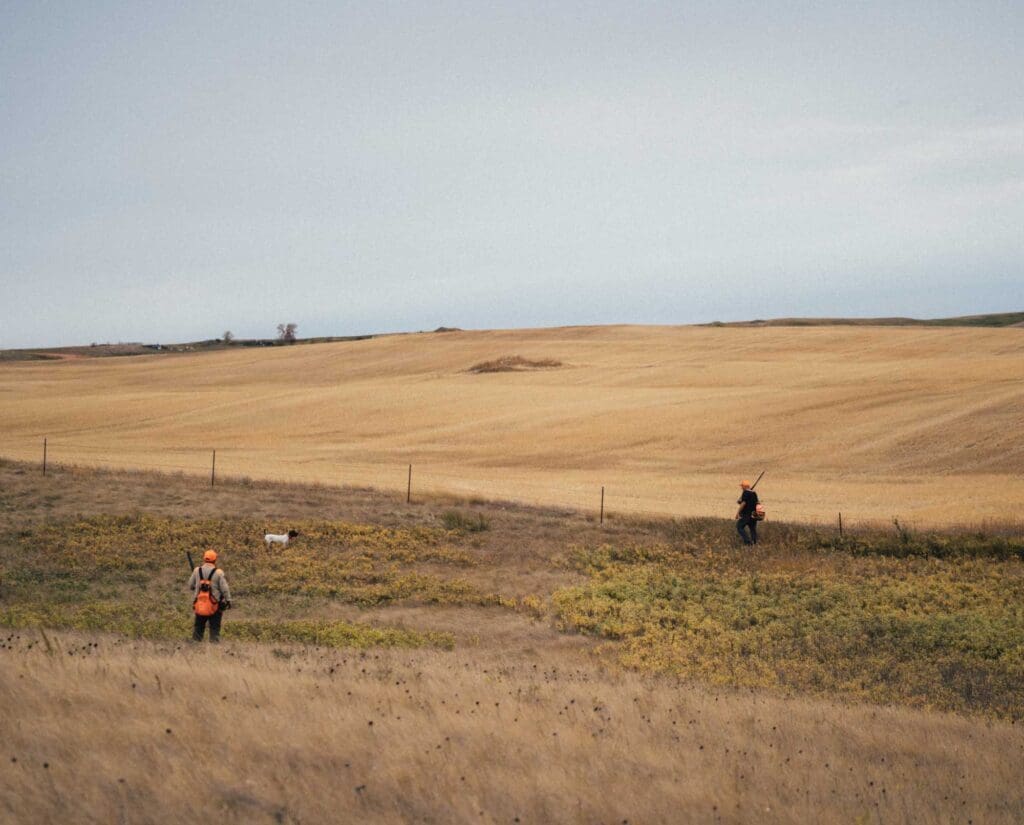
Act Four: The People
Above all things with Tyler, I have always been struck by his generosity and his willingness to share.
I am not sure it’s as simple as “introducing new people;” it’s something deeper inside of him that manifests in mentorship. I am envious of his ability to find friends with such ease, share with such openness, and live with such candidness. While brief snapshots taken from the outside looking in may make it seem as though he lives unapologetically, those who spend time with him know his deep contemplations on anything and everything, with little bias in the way. In that regard, Tyler has life figured out, and you can see that he is happy.
“I feel like it’s my duty a bit—I was blessed by geography, to grow up in a place like this with somebody who taught me how to bird hunt. I went through my phases just like every other hunter,” he said. “But in the last 10 years, I get way more joy out of watching other people see places and birds that they have never seen before and hunt them with my dogs.”
“Bird hunting is supposed to be fun. It’s supposed to be social. It’s not supposed to be super serious. That’s why we like doing this: to be able to walk across the prairie with friends and bust their chops for missing a gimmie. I really want the podcast to be a diary of my hunting season . . . My thought was how cool it would have been to have an audio recording of my grandfather and his brothers. They say a picture is
worth a thousand words, but what’s an hour-long conversation worth? It’s priceless. I have had people on my podcast now that aren’t here anymore . . . But the podcast is going to live forever.”
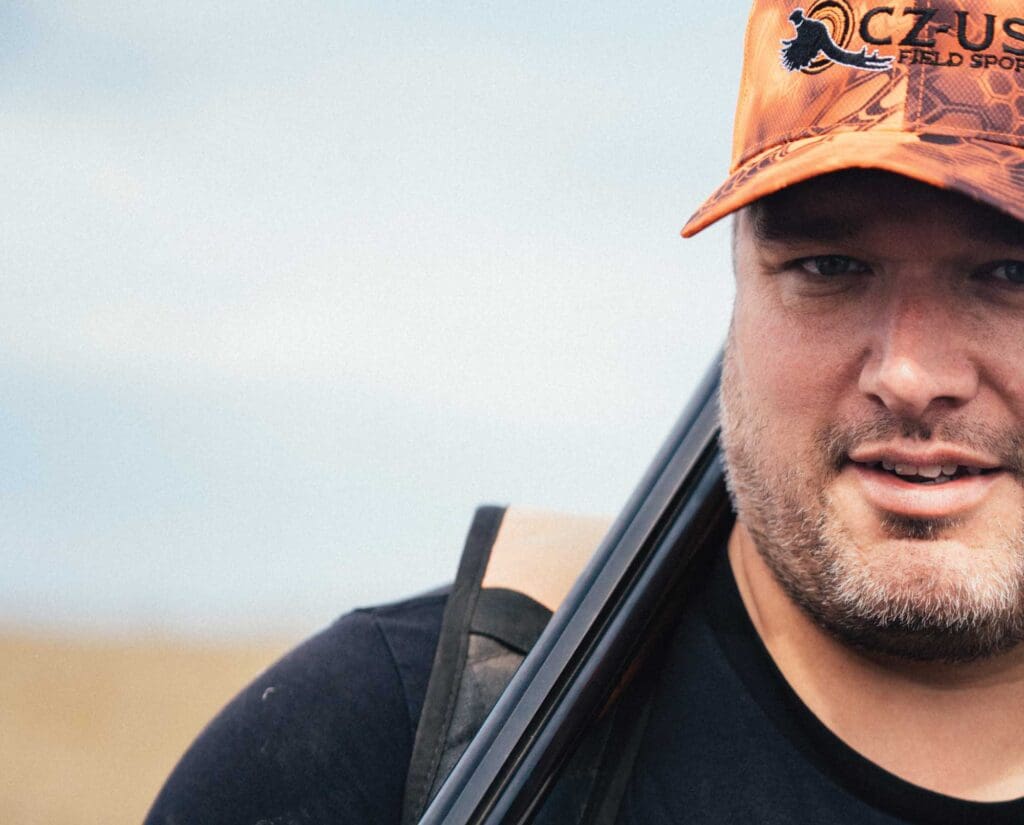
Act Five: A Love Letter
The sun warms the lingering air from the cool night before. The smell of moisture hangs in the air from a drizzle that fell short of quenching the prairie’s thirst. The wind gusts with passion, only to fall silent and still. Frozen in time, a dog stands like a statue with no motion to remind us that we are real. Rose hips gleam red from the green below as our feet shuffle to the pointer just ahead of us. A cackle, another cackle, and a cackle of many, as the birds beat their wings and laugh away in the morning air. This is what I imagine a love letter to North Dakota might read like.
But love is complex; it evolves and it requires history, not the brief lust of a traveler to unveil. And love is not merely a declaration, but a collection of things often overlooked. It is the hours without words, simply being, just coexisting. Can one be in love with a place? I would think so, or at least I have thought I have felt so.
The thing about Tyler’s story is how much it is not about him; it is about the things he loves. Collectively, they make up a reality that is his North Dakota. It is the birds and the prairie. It is friends, dogs, shotguns, and the wild places along the way. While I cannot write a love letter to this wondrous place, I can at least write a love story about North Dakota as observed in a brief moment in time. While Tyler may not be the first, and will not be the last, his love for North Dakota feels ever-present. When your heart is content and your soul is fulfilled, it’s safe to say that you’re in love.
A.J. DeRosa, founder of Project Upland, is a New England native with over 35 years of hunting experience across three continents. His passion for upland birds and side-by-side shotguns has taken him around the world, uncovering the stories of people and places connected to the uplands. First published in 2004, he wrote The Urban Deer Complex in 2014 and soon discovered a love for filmmaking, which led to the award-winning Project Upland film series. A.J.'s dedication to wildlife drives his advocacy for conservation policy and habitat funding at both federal and state levels. He serves as Vice Chair of the New Hampshire Fish & Game Commission, giving back to his community. You can often find A.J. and his Wirehaired Pointing Griffon, Grim, hunting in the mountains of New England—or wherever the birds lead them.

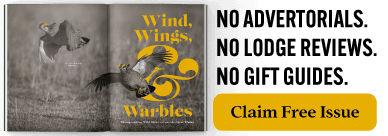


This was the best video I have seen in a long time. My time in North Dakota has been very special to me and my son. I can feel so much of this “Love Letter” in my own hunting! Please keep up the great work.